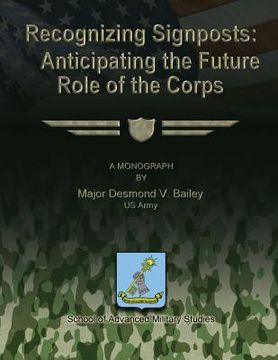Reseña del libro "Recognizing Signposts: Anticipating the Future Role of the Corps (en Inglés)"
By examining four historical contexts featuring corps headquarters performing their doctrinal roles, this study identified three signposts that assist practitioners with anticipating the future role of a corps headquarters at onset and throughout the duration of a campaign. These signposts are the nature of the conflict, the campaign objectives by phase, and the theater structure. Using these signposts as a framework for historical analysis, the assessment demonstrates that when the operational environment presents traditional warfare, and the campaign objectives require the conduct of large-scale offensive and defensive operations with multiple divisions and corps, then a corps headquarters will perform the role of an intermediate tactical headquarters. When the operational environment presents a mix of traditional and irregular warfare requiring the conduct of small-scale offensive and defensive operations with one division and one corps headquarters, the corps headquarters will perform the role of a joint task force headquarters. However, when the operational environment presents a mix of traditional and irregular warfare requiring the conduct of large-scale full spectrum operations with multiple divisions and the integration of joint, interagency, intergovernmental and multinational efforts, the corps headquarters may perform the role of a joint task force for a relatively short period of time, followed by transition to its role as a land component command headquarters. The purpose of this study is not to provide a Nostradamus-style prediction of the future role of a corps headquarters. However, since preparing to perform multiple roles effectively presents numerous training challenges, the study provides future corps practitioners with a historical framework for inquiry that can assist with anticipating the future role of a corps headquarters. To validate the framework logic, the study presented analysis of four historical contexts featuring the corps headquarters performing single or multiple doctrinal roles. The structure of the study describes the four doctrinal roles a corps headquarters may perform, incorporating historical contexts, while using the three signposts as the framework for analysis and synthesis. The first section describes the role and functions of a corps as an intermediate tactical headquarters and uses Operation Desert Shield/Desert Storm, and the initial phases of Operation Iraqi Freedom as the historical contexts for analysis. The second section describes the role and functions of a corps as a joint task force headquarters and uses Operation Uphold Democracy, Operation Enduring Freedom, and Operation Iraqi Freedom as the historical context for analysis. The third section describes the role and functions of a corps as a land component command with Army force responsibilities and uses Operation Iraqi Freedom as the historical context. The final section provides conclusions and recommendations based on analysis and synthesis of the findings in the previous three sections. Based on the assessment, and supported by the 2010 Army Operating Concept, the future role of a corps headquarters is to function as either a joint task force, or a land component command. To perform either role effectively requires corps headquarters, as well as higher commands such as combatant commanders and theater armies, to focus on three areas; training for both roles, adequate preparation time, assisting with manning requirements, and providing the requisite experience level to achieve campaign objectives.

